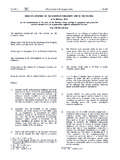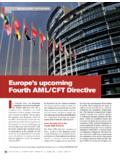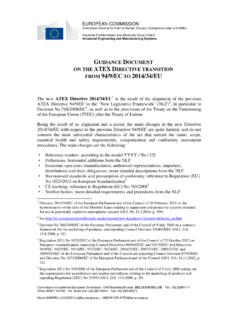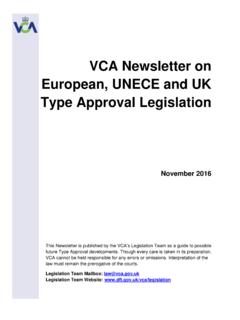Transcription of DIRECTIVE (EU) 2016/ 797 OF THE EUROPEAN …
1 DIRECTIVES DIRECTIVE (EU) 2016/ 797 OF THE EUROPEAN parliament AND OF THE COUNCIL of 11 May 2016 on the interoperability of the rail system within the EUROPEAN union (recast) (Text with EEA relevance) THE EUROPEAN parliament AND THE COUNCIL OF THE EUROPEAN union , Having regard to the Treaty on the Functioning of the EUROPEAN union , and in particular Article 91(1) and Articles 170 and 171 thereof, Having regard to the proposal from the EUROPEAN Commission, After transmission of the draft legislative act to the national parliaments, Having regard to the opinion of the EUROPEAN Economic and Social Committee (1), Having regard to the opinion of the Committee of the Regions (2), Acting in accordance with the ordinary legislative procedure (3), Whereas: (1) DIRECTIVE 2008/57/EC of the EUROPEAN parliament and of the Council (4) has been substantially amended several times.
2 Since further amendments are to be made, that DIRECTIVE should be recast in the interests of clarity. (2) In order to enable citizens of the union , economic operators and competent authorities to benefit to the full from the advantages deriving from the establishment of a single EUROPEAN railway area, it is appropriate, in particular, to improve the interlinkage and interoperability of the national rail networks as well as access to those networks and to implement any measures that may be necessary in the field of technical standardisation as provided for in Article 171 of the Treaty on the Functioning of the EUROPEAN union (TFEU).
3 (3) The pursuit of interoperability within the union rail system should lead to the definition of an optimal level of technical harmonisation and make it possible to facilitate, improve and develop international rail transport services within the union and with third countries, and contribute to the progressive creation of the internal market in equipment and services for the construction, renewal, upgrading and operation of the union rail system. (4) In order to contribute to the completion of the single EUROPEAN railway area, reduce the costs and duration of authorisation procedures and improve railway safety it is appropriate to streamline and harmonise authorisation procedures at union level.
4 (5) Metros, trams and other light rail systems are subject in many Member States to local technical requirements. Such local public transport systems are usually not subject to licensing within the union . Trams and light rail systems are furthermore often subject to road legislation because of shared infrastructure. For those reasons, such local systems do not need to be interoperable and should therefore be excluded from the scope of this DIRECTIVE . This does not prevent Member States from applying the provisions of this DIRECTIVE to local rail systems on a voluntary basis if they deem this appropriate.
5 L 138/44 Official Journal of the EUROPEAN union EN (1) OJ C 327, , p. 122. (2) OJ C 356, , p. 92. (3) Position of the EUROPEAN parliament of 26 February 2014 (not yet published in the Official Journal) and position of the Council at first reading of 10 December 2015 (OJ C 57, , p. 1). Position of the EUROPEAN parliament of 28 April 2016 (not yet published in the Official Journal). (4) DIRECTIVE 2008/57/EC of the EUROPEAN parliament and of the Council of 17 June 2008 on the interoperability of the rail system within the Community (OJ L 191, , p. 1). (6) A tram-train is a public-transport concept which allows for a combined operation on both light-rail infrastructure and heavy-rail infrastructure.
6 Member States should be permitted to exclude from the scope of the measures implementing this DIRECTIVE those vehicles primarily used on light-rail infrastructure but equipped with some heavy-rail components necessary to enable transit to be effected on a confined and limited section of heavy-rail infrastructure for connectivity purposes only. When tram-trains use railway infrastructure, compliance with all essential requirements should be ensured, as well as compliance with the expected safety level on the relevant lines. For cross-border cases, competent authorities should cooperate.
7 (7) The commercial operation of trains throughout the rail network requires, in particular, excellent compatibility between the characteristics of the infrastructure and those of the vehicles, as well as efficient interconnection of the information and communication systems of the different infrastructure managers and railway undertakings. Performance levels, safety, quality of service and cost depend upon such compatibility and interconnection, as does, in particular, the interoperability of the union rail system. (8) The railway regulatory framework at union and Member State level should set clear roles and responsibilities for ensuring compliance with the safety, health and consumer protection rules applying to the railway networks.
8 This DIRECTIVE should not lead to a reduced level of safety or increase costs in the union rail system. To that end, the EUROPEAN union Agency for Railways ( the Agency ) established by Regulation (EU) 2016/ 796 of the EUROPEAN parliament and of the Council (1) and the national safety authorities should take full responsibility for the author isations they issue. (9) Major differences exist between national regulations, internal rules and technical specifications applicable to rail systems, subsystems and components, since they incorporate techniques that are specific to the national industries and lay down specific dimensions and devices as well as special characteristics.
9 That situation may prevent trains from running without hindrance throughout the union . (10) In order to enhance their competitiveness at world level, the union railway industries require an open and competitive market. (11) It is therefore appropriate to define essential requirements relating to rail interoperability for the whole of the union which should apply to its rail system. (12) The development of technical specifications for interoperability ( TSIs ) has shown the need to clarify the relationship between the essential requirements and TSIs on the one hand, and the EUROPEAN standards and other documents of a normative nature on the other.
10 In particular, a clear distinction should be drawn between the standards or parts of standards which should be made mandatory in order to achieve the objectives of this DIRECTIVE , and the harmonised standards that have been developed in accordance with Regulation (EU) No 1025/2012 of the EUROPEAN parliament and of the Council (2). Where strictly necessary, the TSIs may make an explicit reference to EUROPEAN standards or specifications, which become mandatory from the moment the TSI is applicable. (13) In order to genuinely increase the competitiveness of the union railway sector without distorting competition between key actors of the union rail system, the TSIs and the recommendations of the Agency related to these TSIs should be drafted by respecting the principles of openness, consensus and transparency as defined in Annex II to Regulation (EU) No 1025/2012.







